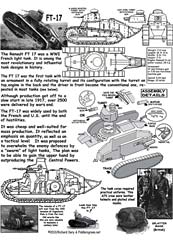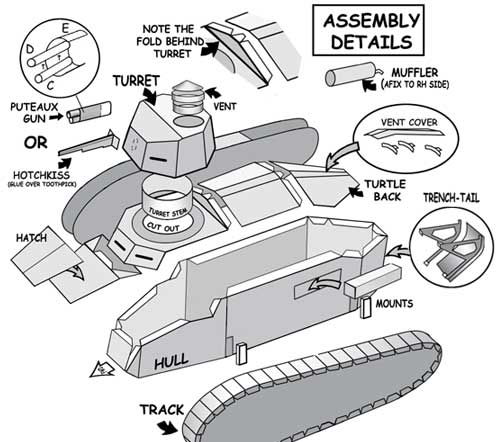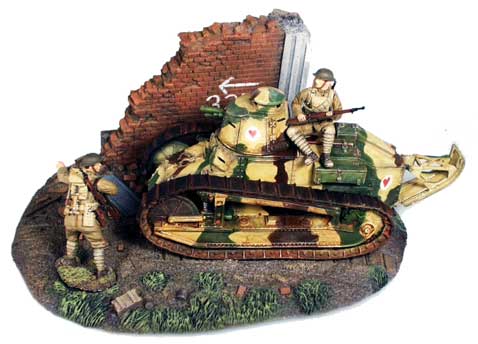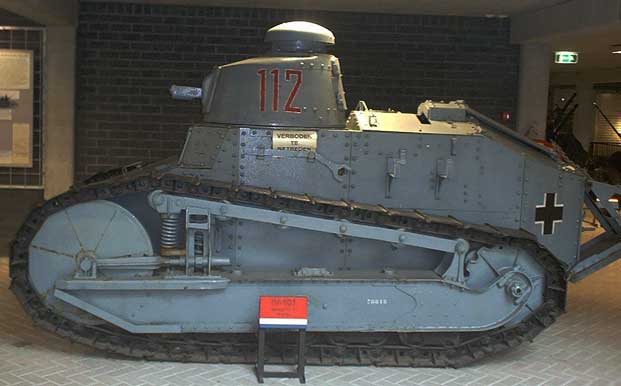


The Early WWI Renault F-17 Light Tank
It could be equipped with cannon or machine gun but its decisive advantage was its light weight -about 7 tons- this meant that it could be loaded on a truck and dispatched to the front ready for action. When the Renault FT 17 was subsequently equipped with a 37 -mm gun, a periscope was also fitted, This gave the crew-the commander, who doubled as gunner, and the driver-an enormous advantage over the blind crew of heavier tanks. |
What People Say:
Gentlemen. Thank you for the Renault 17 Tank. It had interesting pictures and text. I understand that Finland bought the type about 1919. It is exhibited at the Finnish Armour Museum at Parola (Tank Museum).
Congratulations for a wonderful job. Sincerely yours John-Bjarne 1/11
WWI Renault F-17 Tank
 |
In July 1916, after much hesitation, the French motor-car manufacturer Louis Renault yielded to General Estienne's pressing demands and it was not long before the first Renault light tank was put to the test of battle. Its success in standing up to competition from other French and British tanks is demonstrated by the fact that vehicles of the same type with only a few minor improvements saw action in North Africa in 1942. It could be equipped at will with cannon or machine gun and its decisive advantage was its light weight-about 7 tons. This meant that it could be loaded on a truck and dispatched to the front ready for action. When the Renault FT 17 was subsequently equipped with a 37-mm gun, a periscope was also fitted. This gave the crew-the commander, who doubled as gunner, and the driver-an enormous advantage over the blind crew of heavier tanks. First employed in very small numbers, the Renault was amazingly successful towards the end of the war. In July 1918 a massive assault in which 480 Renaults were thrown into the fray cut a hole about four miles deep in the German defenses. This breakthrough, which had not been prepared by an artillery barrage, was not transformed into a decisive victory because the only reserves that could be thrown into the breach were the French cavalry, an arm that had long been given up as useless by both sides. |
 |
 |
The side armour of 8 mm initially made them largely immune to small arms fire, but could be penetrated when the Germans developed armour-piercing K bullets.  |
|
Powerplant: Operators: Afghanistan; Belgium; Brazil; Czechoslovakia; Estonia; Finland; France; Iran; Italy; Japan; Lithuania; Netherlands; Poland; Romania; Soviet Union; Spain; Switzerland; Turkey; United States (M1917); Yugoslavia |
 |
 In France, there were multiple and conflicting lines of development which were badly integrated, resulting in three major and quite disparate production types. A major arms producer, Schneider, took the lead in January 1915 and tried to build a first armored vehicle Schneider CA1(right) In France, there were multiple and conflicting lines of development which were badly integrated, resulting in three major and quite disparate production types. A major arms producer, Schneider, took the lead in January 1915 and tried to build a first armored vehicle Schneider CA1(right)  based on the Baby Holt tractor(left) but initially the development process was slow until in July they received political, even presidential, support . In December 1915, the influential Colonel Estienne made the Supreme Command very enthusiastic about the idea of creating an armored force based on these vehicles; strong Army support for tanks would be a constant during the decades to come. based on the Baby Holt tractor(left) but initially the development process was slow until in July they received political, even presidential, support . In December 1915, the influential Colonel Estienne made the Supreme Command very enthusiastic about the idea of creating an armored force based on these vehicles; strong Army support for tanks would be a constant during the decades to come. |
  (left), 1905 Steam tractor (right) 1902 Armored Car |
 The diminutive FT-17 (left) first entered combat on May 31, 1918, at Foret de Retz, south-west of Soissons, and aided the 10th Army in slowing the German drive on Paris. |
 The two tanks on top of each other are FIAT's. FIAT built them under license as the FIAT 3000. On the left you can clearly see: 'R.E'. Short for: Regia Esercito. (Royal Army) One wonders why these tanks are parked like this.. Perhaps it was an eye catching display or maybe a unique way to 'clamp' an illegal parker. |
 Richard holding the small version Renault FT-17 and showing his Mark-IV |
 Richard Dery, Torrington, CT..is crazy nutz for tanks and is well on his way creating an outstanding Fiddlersgreen WWI Tank Collection. The ruined wall in this photo is included with the Renault FT-17 WWI tank |
 |
 A carefully created diorama is as good as it gets! |
 |
 |
 |
Inside photos of the WWI French Renault FT-17 Light Tank |
||

The Germans captured and recycled the Renault FT-17 |
 |
 |
 You can see the small scale of the Renault WWI Light tank. The FT-17's small size increased its value as it was capable of traversing terrain, such as forests, that other heavy tanks were incapable of negotiating. |
 This is the most common camo FT-17 version |
 Side view of the FT-17 light tank |
 |
 Two rear views of the US FT-17 |
 |
As the tide turned in the Allies favor, France and its allies finally produced large numbers of the FT-17, which allowed for effective counterattacks against German positions. |
 |
 |
 |
Some interesting WWI American posters publicizing the food shortage in France.. |
||
 |
 |
 Above are photos of wrecked FT-17s gleaned from the internet. (right) Chip and Sister Emmy (1943) in snazzy Easter outfits looking over what the Easter Bunny left. |
 |
And finally, the Curious (and kinda scary) WWI Tank Crew's Splatter Mask...
(right) You see a German A7V tank crew showing off their leather helmets and outer wear of heavy leather. |
 Cast zinc toy of the Renault FT-17 Tank- |
Deutsches Panzermuseum - German Tank Museum WWI Tanks in the Fiddlersgreen collection (Feb 2011)
|

 |



 In July 1916, after much hesitation, the French motor-
In July 1916, after much hesitation, the French motor- car manufacturer Louis Renault yielded to General Estienne's pressing demands and it was not long before the first Renault light tank was put to the test of battle. Its success in standing up to competition from other French and British tanks is demonstrated by the fact that vehicles of the same type with only a few minor improvements saw action in North Africa in 1942.
car manufacturer Louis Renault yielded to General Estienne's pressing demands and it was not long before the first Renault light tank was put to the test of battle. Its success in standing up to competition from other French and British tanks is demonstrated by the fact that vehicles of the same type with only a few minor improvements saw action in North Africa in 1942.
 (left) To counter the fumes inside and the danger of bullet splash or fragments and rivets
(left) To counter the fumes inside and the danger of bullet splash or fragments and rivets